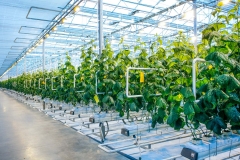
FACULTY OF BUSINESS
Department of Economics
ECON 408 | Course Introduction and Application Information
| Course Name |
Advanced Economic Growth Theory
|
|
Code
|
Semester
|
Theory
(hour/week) |
Application/Lab
(hour/week) |
Local Credits
|
ECTS
|
|
ECON 408
|
Fall/Spring
|
3
|
0
|
3
|
6
|
| Prerequisites |
None
|
|||||
| Course Language |
English
|
|||||
| Course Type |
Elective
|
|||||
| Course Level |
First Cycle
|
|||||
| Mode of Delivery | - | |||||
| Teaching Methods and Techniques of the Course | - | |||||
| Course Coordinator | - | |||||
| Course Lecturer(s) | ||||||
| Assistant(s) | - | |||||
| Course Objectives | The aim of this course is to introduce advanced models of economic growth theory. Economic theory, differential equations, and optimal control theory is assumed to be known in this course. The course also aims to teach how to make theoretical research and publications. |
| Learning Outcomes |
The students who succeeded in this course;
|
| Course Description | The course begins by Lucas (1988). That paper develops a framework that set sup a link between human capital and economic growth. Next, Barro (1990) is studied. That paper focuses on the role played by public capital on economic growth. Third, Romer (1990) is analyzed. Romer (1990) develops an endogenous growth framework that reveals the role of technological change on economic growth. Fourth, the seminal paper by Aghion and Howitt (992) on vertical product differentiation is reviewed. That paper shows the importance of quality improvements on economic growth. Fifth, Dasgupta and Heal (1974) is reviewed to understand the importance of nonrenewable resources on economic growth. |
|
|
Core Courses | |
| Major Area Courses |
X
|
|
| Supportive Courses | ||
| Media and Management Skills Courses | ||
| Transferable Skill Courses |
WEEKLY SUBJECTS AND RELATED PREPARATION STUDIES
| Week | Subjects | Related Preparation |
| 1 | Revision | Main reading: Chapters 1 and 2 of Barro and SalaiMartin (2003). / Additional Reading: Solow, R.M. (1956), “A Contribution to the Theory of Economic Growth”, Quarterly Journal of Economics 70, 6594. / Cass, D. (1965), “Optimum Growth in an Aggregative Model of Capital Accumulation,” Review of Economic Studies 32, 233240. / Ramsey, F.P. (1928), “A Mathematical Theory of Saving,” Economic Journal 38, 543559. |
| 2 | Revision | Main reading: Chapters 1 and 2 of Barro and SalaiMartin (2003). / Additional Reading: Solow, R.M. (1956), “A Contribution to the Theory of Economic Growth”, Quarterly Journal of Economics 70, 6594. / Cass, D. (1965), “Optimum Growth in an Aggregative Model of Capital Accumulation,” Review of Economic Studies 32, 233240. / Ramsey, F.P. (1928), “A Mathematical Theory of Saving,” Economic Journal 38, 543559. |
| 3 | Endogenous Growth I: Humancapital Models | Main reading: Lucas, R.E., Jr. (1988), “On the Mechanics of Economic Development,” Journal of Monetary Economics 22, 342. / Additional Reading: Chapter 5 of Barro and SalaiMartin (2003) / Mankiw, N. G., Romer, D. and Weil, D. N. (1992), “A Contribution to the Empirics of Economic Growth”, Quarterly Journal of Economics, 407437. / Barro, Robert J. (2001), “Human Capital and Growth”, American Economic Review, May, 91(2), 1217. |
| 4 | Endogenous Growth I: Humancapital Models | Main reading: Lucas, R.E., Jr. (1988), “On the Mechanics of Economic Development,” Journal of Monetary Economics 22, 342. / Additional Reading: Chapter 5 of Barro and SalaiMartin (2003) / Mankiw, N. G., Romer, D. and Weil, D. N. (1992), “A Contribution to the Empirics of Economic Growth”, Quarterly Journal of Economics, 407437. / Barro, Robert J. (2001), “Human Capital and Growth”, American Economic Review, May, 91(2), 1217. |
| 5 | Endogenous Growth II: Government / Public Capital Models | Main reading: Barro, Robert (1990), “Government spending in a simple model of endogenous growth”, Journal of Political Economy, 98(5), S103117. / Glomm G. and Ravikumar B. (1994), “Public investment in infrastructure in a simple growth model”, Journal of Economic Dynamics and Control, 18, 117387. / Additional Reading: Chapter 4 of Barro and SalaiMartin (2003) / Jones, L., Manuelli, R. and Rossi P. (1993). Optimal taxation in models of endogenous growth. Journal of Political Economy, 101(3), 485519. |
| 6 | Endogenous Growth II: Government / Public Capital Models | Main reading: Barro, Robert (1990), “Government spending in a simple model of endogenous growth”, Journal of Political Economy, 98(5), S103117. / Glomm G. and Ravikumar B. (1994), “Public investment in infrastructure in a simple growth model”, Journal of Economic Dynamics and Control, 18, 117387. / Additional Reading: Chapter 4 of Barro and SalaiMartin (2003) / Jones, L., Manuelli, R. and Rossi P. (1993). Optimal taxation in models of endogenous growth. Journal of Political Economy, 101(3), 485519. |
| 7 | Endogenous Growth III: Endogenous Technological Change Models | Main reading: Romer, P.M. (1990), “Endogenous Technological Change,” Journal of Political Economy 98, 71102. / Additional Reading: Chapter 6 of Barro and SalaiMartin (2003) / Rebelo, S. (1991), “LongRun Policy Analysis and Growth,” Journal of Political Economy 99, 500521. |
| 8 | Endogenous Growth III: Endogenous Technological Change Models | Main reading: Romer, P.M. (1990), “Endogenous Technological Change,” Journal of Political Economy 98, 71102. / Additional Reading: Chapter 6 of Barro and SalaiMartin (2003) / Rebelo, S. (1991), “LongRun Policy Analysis and Growth,” Journal of Political Economy 99, 500521. |
| 9 | Review session | |
| 10 | Midterm | |
| 11 | Endogenous Growth IV: Schumpeterian (QualityLadder) Models | Main reading: Aghion, P., and P. Howitt (1992), “A Model of Growth Through Creative Destruction,” Econometrica60, 323351. / Additional Reading: Chapter 7 of Barro and SalaiMartin (2003) |
| 12 | Endogenous Growth IV: Schumpeterian (QualityLadder) Models | Main reading: Aghion, P., and P. Howitt (1992), “A Model of Growth Through Creative Destruction,” Econometrica60, 323351. / Additional Reading: Chapter 7 of Barro and SalaiMartin (2003) |
| 13 | Nonrenewable Resource Dependent Growth | Main reading: Dasgupta, P. and G.M. Heal (1974), “The Optimal Depletion of Exhaustible Resources", Review of Economic Studies, Symposium on the Economics of Exhaustible Resources: 328. / Additional Reading: Stiglitz, J. (1974), “Growth with Exhaustible Natural Resources: Efficient and Optimal Growth Paths”, Review of Economic Studies, Symposium on the Economics of Exhaustible Resources: 123137 |
| 14 | Nonrenewable Resource Dependent Growth | Main reading: Dasgupta, P. and G.M. Heal (1974), “The Optimal Depletion of Exhaustible Resources", Review of Economic Studies, Symposium on the Economics of Exhaustible Resources: 328. / Additional Reading: Stiglitz, J. (1974), “Growth with Exhaustible Natural Resources: Efficient and Optimal Growth Paths”, Review of Economic Studies, Symposium on the Economics of Exhaustible Resources: 123137 |
| 15 | Review session | |
| 16 | Review of the Semester |
| Course Notes/Textbooks | There is no official textbook of this course. However, I strongly advise you to get a copy of Barro, R.J., and X. SalaiMartin, Economic Growth, The MIT Press; 2nd edition (October 1, 2003). In addition to this, my course material will also be distributed. |
| Suggested Readings/Materials | Solow, R.M. (1956), “A Contribution to the Theory of Economic Growth”, Quarterly Journal of Economics 70, 6594.Cass, D. (1965), “Optimum Growth in an Aggregative Model of Capital Accumulation,” Review of Economic Studies 32, 233240.Ramsey, F.P. (1928), “A Mathematical Theory of Saving,” Economic Journal 38, 543559.Lucas, R.E., Jr. (1988), “On the Mechanics of Economic Development,” Journal of Monetary Economics 22, 342.Mankiw, N. G., Romer, D. and Weil, D. N. (1992), “A Contribution to the Empirics of Economic Growth”, Quarterly Journal of Economics, 407437.Barro, Robert J. (2001), “Human Capital and Growth”, American Economic Review, May, 91(2), 1217.Barro, Robert (1990), “Government spending in a simple model of endogenous growth”, Journal of Political Economy, 98(5), S103117.Glomm G. and Ravikumar B. (1994), “Public investment in infrastructure in a simple growth model”, Journal of Economic Dynamics and Control, 18, 117387. Jones, L., Manuelli, R. and Rossi P. (1993). Optimal taxation in models of endogenous growth. Journal of Political Economy, 101(3), 485519. Romer, P.M. (1990), “Endogenous Technological Change,” Journal of Political Economy 98, 71102.Rebelo, S. (1991), “LongRun Policy Analysis and Growth,” Journal of Political Economy 99, 500521.Aghion, P., and P. Howitt (1992), “A Model of Growth Through Creative Destruction,” Econometrica60, 323351.Dasgupta, P. and G.M. Heal (1974), “The Optimal Depletion of Exhaustible Resources", Review of Economic Studies, Symposium on the Economics of Exhaustible Resources: 328.Stiglitz, J. (1974), “Growth with Exhaustible Natural Resources: Efficient and Optimal Growth Paths”, Review of Economic Studies, Symposium on the Economics of Exhaustible Resources: 123137 |
EVALUATION SYSTEM
| Semester Activities | Number | Weigthing |
| Participation |
16
|
10
|
| Laboratory / Application | ||
| Field Work | ||
| Quizzes / Studio Critiques | ||
| Portfolio | ||
| Homework / Assignments |
1
|
10
|
| Presentation / Jury | ||
| Project | ||
| Seminar / Workshop | ||
| Oral Exams | ||
| Midterm |
1
|
40
|
| Final Exam |
1
|
40
|
| Total |
| Weighting of Semester Activities on the Final Grade |
60
|
|
| Weighting of End-of-Semester Activities on the Final Grade |
40
|
|
| Total |
ECTS / WORKLOAD TABLE
| Semester Activities | Number | Duration (Hours) | Workload |
|---|---|---|---|
| Theoretical Course Hours (Including exam week: 16 x total hours) |
16
|
3
|
48
|
| Laboratory / Application Hours (Including exam week: '.16.' x total hours) |
16
|
0
|
|
| Study Hours Out of Class |
16
|
3
|
48
|
| Field Work |
0
|
||
| Quizzes / Studio Critiques |
0
|
||
| Portfolio |
0
|
||
| Homework / Assignments |
1
|
14
|
14
|
| Presentation / Jury |
0
|
||
| Project |
0
|
||
| Seminar / Workshop |
0
|
||
| Oral Exam |
0
|
||
| Midterms |
1
|
25
|
25
|
| Final Exam |
1
|
30
|
30
|
| Total |
165
|
COURSE LEARNING OUTCOMES AND PROGRAM QUALIFICATIONS RELATIONSHIP
|
#
|
Program Competencies/Outcomes |
* Contribution Level
|
||||
|
1
|
2
|
3
|
4
|
5
|
||
| 1 | To be able to acquire a sound knowledge of fundamental concepts, theories, principles and methods of investigation specific to the economic field. |
X | ||||
| 2 | To be able to apply adequate mathematical, econometric, statistical and data analysis models to process economic data and to implement scientific research for development of economic policies. |
|||||
| 3 | To be able to participate in academic, professional, regional, and global networks and to utilize these networks efficiently. |
|||||
| 4 | To be able to have adequate social responsibility with regards to the needs of the society and to organize the activities to influence social dynamics in line with social goals. |
|||||
| 5 | To be able to integrate the knowledge and training acquired during the university education with personal education and produce a synthesis of knowledge one requires. |
|||||
| 6 | To be able to evaluate his/her advance level educational needs and do necessary planning to fulfill those needs through the acquired capability to think analytically and critically. |
X | ||||
| 7 | To be able to acquire necessary skills to integrate social dynamics into economic process both as an input and an output. |
X | ||||
| 8 | To be able to link accumulated knowledge acquired during the university education with historical and cultural qualities of the society and be able to convey it to different strata of society. |
X | ||||
| 9 | To be able to take the responsibility as an individual and as a team member. |
|||||
| 10 | To be able to attain social, scientific and ethical values at the data collection, interpretation and dissemination stages of economic analysis. |
X | ||||
| 11 | To be able to collect data in economics and communicate with colleagues in a foreign language ("European Language Portfolio Global Scale", Level B1) |
|||||
| 12 | To be able to speak a second foreign at a medium level of fluency efficiently. |
|||||
| 13 | To be able to relate the knowledge accumulated throughout human history to their field of economics. |
|||||
*1 Lowest, 2 Low, 3 Average, 4 High, 5 Highest
NEWS |ALL NEWS

Elif’s boundless success
Elif Larende (22), who graduated from Izmir University of Economics (IUE) Faculty of Business, Department of Economics with the second place this

‘Digital waiter’ ranks third
Mehmet Güler, a student of Izmir University of Economics (IUE) Department of Economics, came third in the ‘Akıl Fikir Yarışması’ (Idea Competition)

'Raspberry' ranks second in Turkey
Izmir University of Economics (IUE) Department of Economics student Mehmet Güler came in second in Turkey with his project called 'Raspberry' aimed
